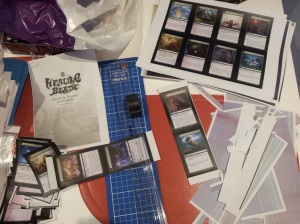This story started in 2011, when I first read about the “Healing blade card game” From Nerdcore in this blog: https://drottematic.wordpress.com/2011/08/11/review-healing-blade-the-infectious-disease-card-battle/. I began to search for this game, knowing it would probably be too advanced for the VCE (Victorian Certificate of Education- Year 12) course I wanted to use it for. Healing blade was developed for Medical students to use as a learning tool- and this is what intrigued me the most, the information within this game wouldn’t be “dumbed down” or incorrect. To me, accuracy is a very important aspect of any game I would want to use as a learning tool.
Unfortunately, the game had a small initial print run and it took me quite a while to find out about the kickstarter movement and track down the print and play version. Late last year I received the newest version of the downloadable file. I was impressed with the quality of the card fronts and really wanted to print these out on card stock for my classes to work with. The months flew by, and the printing of the cards was pushed on down the priority list. Then the sudden realisation that I need the cards for my class this week hit me! So, I have compromised and printed out my card set on a normal photocopy paper. I spent a couple of hours yesterday cutting up the paper cards and backs and sliding them into plastic card holders (Thanks MindGames on Swanston St for your help in sizing the right ones).
Sometimes the work of teaching is ‘making’ the resources 🙂
Now the game is ready to play.
Along with 6 other Biology based games, Healing blade will be considered by my students this week, and critiqued as a possible classroom tool.
I hope, in the coming weeks, that I will blog about our impressions of each of the 7 games we will critique, so stay tuned 🙂 (or link the RSS feed to your email, so you don’t miss out!)
Until next time,
Fiona T







